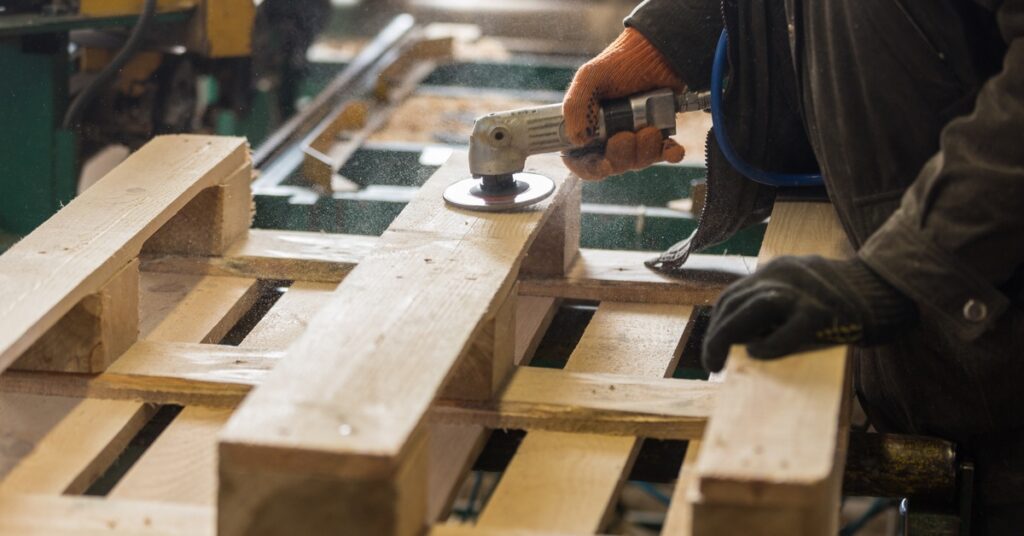The Differences Between Repaired and Remanufactured Pallets
Pallets serve as the foundation of modern logistics, facilitating the movement of billions of dollars’ worth of goods across supply chains every day. These wooden platforms enable the efficient transportation, storage, and handling of products from manufacturing facilities to retail stores.
Understanding the distinction between repaired and remanufactured pallets has a significant impact on your operational efficiency and bottom line. The choice between these two options affects everything from load capacity to long-term costs. Read on to make an informed decision for your shipping operations.
What Are Repaired Pallets?
Repaired pallets are existing wooden platforms that undergo basic fixes to restore their functionality. The repair process typically involves replacing damaged boards, reinforcing weak joints, and securing loose fasteners. Common materials used in pallet repair include replacement deck boards, stringers, and galvanized nails or screws.
These repairs address immediate structural issues while maintaining the original pallet’s basic framework. The goal is to extend the useful life of pallets that businesses would otherwise discard due to minor damage or wear.
What Are Remanufactured Pallets?
Remanufactured pallets represent a complete reconstruction approach using salvaged materials from multiple sources. This process involves dismantling old pallets and combining usable components with new materials to create a standardized product.
The remanufacturing approach transforms various grades of used lumber into pallets that meet specific quality standards. These pallets often incorporate recycled materials while maintaining consistent dimensions and load-bearing capabilities. The result is a product made from existing resources that performs like new.
Key Differences Between Repaired and Remanufactured Pallets
The structural differences are substantial and impact the performance characteristics of recycled pallets. Repaired pallets maintain their original construction with selective component replacement, while remanufactured pallets feature entirely reconstructed frameworks. Material composition varies significantly, with repaired pallets typically retaining the majority of their original lumber and remanufactured versions incorporating a mix of materials.
The appearance differences between repaired and remanufactured pallets are noticeable, as repaired pallets exhibit varying degrees of wear, while remanufactured pallets present a more uniform aesthetic. Performance capabilities differ based on the extent of reconstruction, with remanufactured pallets often providing more predictable load-bearing characteristics.
The Repair Process Explained
The pallet repair process begins with inspection to identify damaged components and assess overall structural integrity. Technicians remove broken or severely worn boards, stringers, and fasteners that compromise the pallet’s functionality. They then measure, cut, and fit the replacement components to match the original specifications and dimensions.
Installation involves securing new parts with appropriate fasteners while ensuring proper alignment and structural stability. Adding touches such as sanding or polishing may be necessary to ensure repaired parts are inconspicuous. Quality control checks verify that repaired pallets meet basic safety and performance standards before returning to service.

The Remanufacturing Process Explained
Remanufacturing starts with the systematic deconstruction of multiple pallets to salvage usable lumber and components. Salvaged materials undergo sorting and grading to determine their suitability for different applications within the reconstruction process. The reconstruction phase combines selected recycled materials with new components to create pallets meeting predetermined specifications.
Assembly follows standardized procedures to ensure consistent quality and performance across all remanufactured units. Final inspection and testing verify that completed pallets meet industry standards and customer requirements.
Benefits of Using Repaired Pallets
Repaired pallets offer exceptional cost-effectiveness for operations requiring basic material handling capabilities without premium performance demands. The repair process extends pallet life cycles while maintaining familiar handling characteristics that warehouse staff are already familiar with.
These pallets provide reliable service for light to moderate load applications where extreme durability isn’t essential. Industries such as retail distribution and general warehousing find repaired pallets perfectly suited to their operational needs. The quick turnaround time for repairs translates to minimal disruption to ongoing supply chain activities.
Benefits of Using Remanufactured Pallets
Remanufactured pallets deliver superior longevity compared to repaired alternatives due to their comprehensive reconstruction approach. Performance improvements result from the combination of proven materials with standardized assembly procedures. These pallets represent a sustainable solution for businesses that wish to demonstrate their commitment to environmental responsibility while maintaining operational efficiency.
The consistent quality standards of remanufactured pallets provide predictable performance across different applications and environments. Many operations find that remanufactured pallets offer the perfect balance between cost savings and reliability.
Drawbacks of Repaired Pallets
Quality inconsistencies represent the primary concern with repaired pallets, as each unit reflects the condition of its original components. Durability limitations become apparent when repaired pallets face heavy loads or challenging environmental conditions.
The selective nature of repairs means that unaddressed wear in non-repaired components leads to unexpected failures. Limited applicability for high-load operations restricts their use in demanding industrial environments. Some customers find that the varied appearance of repaired pallets doesn’t meet their presentation standards.
Drawbacks of Remanufactured Pallets
The higher initial cost of remanufactured pallets strains budgets focused on short-term expense management. Processing time for remanufacturing typically exceeds that of simple repairs, potentially affecting immediate availability.
Some industries have specific requirements that may limit the applicability of standardized remanufactured designs. The mixed-material composition, while generally advantageous, may not suit applications requiring uniform wood characteristics. Quality variations in source materials occasionally affect the final product despite careful selection processes.
Environmental Impact of Repaired and Remanufactured Pallets
Environmental benefits distinguish repaired and remanufactured pallets from new products through their utilization of existing materials. Repaired pallets extend the service life of damaged units while requiring minimal additional resources for restoration. This approach reduces waste generation and delays the need for disposal or recycling.
Remanufacturing, on the other hand, involves the disassembly of damaged pallets and reconstruction with reclaimed components. This process has a slightly higher environmental impact compared to repair due to the use of additional energy and resources during production. However, the overall environmental footprint is significantly lower than that of new pallets, as it reduces the need for raw materials extraction and manufacturing processes.

Industry Applications and Use Cases
Retail distribution centers often prefer repaired pallets due to their cost-effectiveness in handling consumer goods with moderate weight requirements. General warehousing operations find used pallets for sale suitable for internal material handling and short-distance transportation needs. Heavy manufacturing industries often require remanufactured pallets to handle substantial loads and withstand demanding operational conditions.
Export operations typically choose remanufactured pallets for their consistent quality and ability to meet international shipping standards. Food and beverage industries may specify either option based on their specific hygiene and performance requirements.
Selecting between repaired and remanufactured pallets requires careful consideration of your specific operational needs and budget constraints. Evaluate your typical load requirements, handling frequency, and environmental conditions to determine which option provides the best value.
Consider the long-term implications of your choice, including replacement costs, downtime risks, and the impact on customer satisfaction. We understand that every operation has unique requirements, and we’re committed to helping you find the perfect pallet solution. Contact Logical & Packaging Logistics today to discuss your specific needs and discover how our expertise can optimize your material handling operations.

